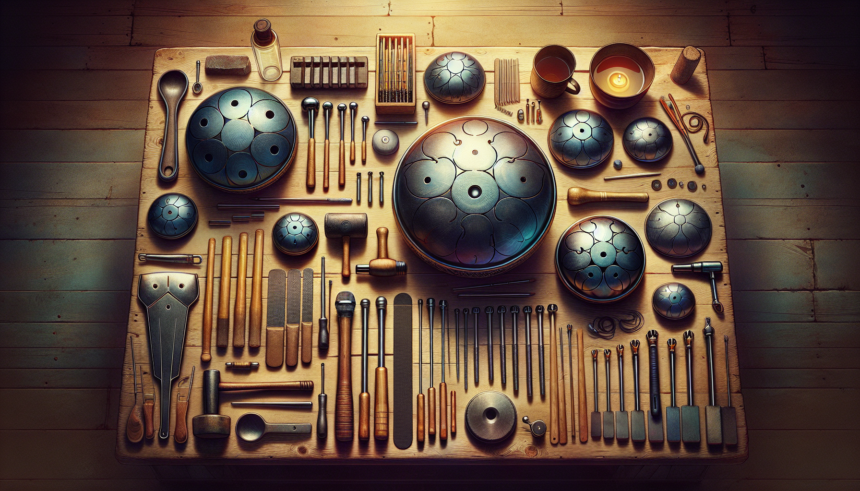The handpan, with its ethereal and captivating resonance, has become an increasingly popular percussion instrument in recent years. Originating from the fusion of various steel instruments and ideophones, its unique sound is a product of meticulous craftsmanship and precise tuning. For musicians and crafters alike, selecting the best tools for handpan tuning is essential to uncovering its fullest musical potential. This article delves into the various tools one might use for tuning a handpan, while providing insights on how to choose the most suitable ones for your needs.
Understanding Handpan Tuning
Handpan tuning is the process of adjusting the tonal regions of the instrument to achieve the desired pitches and harmonics. This intricate procedure requires a good ear for pitch, technical expertise, and the appropriate toolkit. Here are some primary considerations to bear in mind:
- Pitch Accuracy: Higher quality tools enhance precision, ensuring that the notes fall within the correct pitch range.
- Tool Durability: Tuning involves repeated strikes and adjustments. Therefore, robustness is key.
- User-friendly: Tools should be ergonomic, lightweight, and easy to handle, allowing the user to focus on tuning nuances rather than grappling with equipment.
Core Tools for Handpan Tuning
To achieve a finely tuned handpan, several core tools are typically required. Below, we review the essential tools along with their specific functionalities:
Tuning Hammers
Description: Tuning hammers are perhaps the most fundamental tools in the handpan tuner’s kit. These hammers come in various sizes, weights, and shapes, each designed to make precise adjustments to the steel shell’s dimples.
Selection Tips:
- Weight: Opt for a range of hammers – light, medium, and heavy – as each has unique applications depending on the pitch and area being tuned.
- Material: Look for hammers made of high-quality materials such as hardened steel. Handles with ergonomic grips will reduce fatigue during prolonged work.
- Shape: Different hammer heads (round, flat, pointed) allow for distinct impact characteristics. Experimenting with various shapes can offer improved control over the tuning process.
Tuning Rings
Description: Tuning rings are metal rings placed around the handpan’s dimples to isolate specific areas while adjusting the pitches. They help in focusing the hammer strikes and minimizing extraneous vibrations.
Selection Tips:
- Fit: Ensure that tuning rings are available in several sizes to match different dimple dimensions.
- Material: Rings made from durable metals like stainless steel provide consistency and longevity.
- Customizability: Some rings offer adjustable features or come in sets that cater to various handpan designs.
Electronic Tuner
Description: An electronic tuner is a crucial modern tool that measures pitch frequencies with high accuracy, guiding the tuner to achieve the exact notes required.
Selection Tips:
- Accuracy: Choose tuners with high sensitivity and a wide range of frequency detection to cover all handpan notes.
- Display: A clear, easy-to-read display helps in quickly confirming pitches and making necessary adjustments.
- Compatibility: Opt for tuners that can clamp onto the handpan or have a microphone to pick up minimal sound variations.
Laser Temperature Gauge
Description: A lesser-known but insightful tool, the laser temperature gauge helps monitor the steel’s temperature. Since temperature changes can affect metal properties and tuning, managing this variable is essential.
Selection Tips:
- Accuracy: Choose a gauge with a quick response time and high accuracy.
- Ease of Use: A digital display and simple operation will enhance usability.
- Durability: Industrial-grade gauges offer better performance and service life.
Optional Yet Beneficial Tools
While the core tools mentioned above are indispensable for effective tuning, incorporating some optional tools can further streamline the process and enhance outcomes:
Rubber Mallets and Wooden Blocks
Rubber Mallets: These are useful for fine-tuning and getting the initial shape of the dimple without the harsh impact of metal hammers.
Wooden Blocks: These serve as a buffer between the hammer and metal surface to prevent over-hammering and control the force impact.
Microfiber Cloths and Cleaning Solutions
Description: Keeping the handpan clean and free from oils and dust ensures better visibility and maintenance of the instrument’s surface.
Magnifying Glass or Scope
Description: A magnifying glass or scope helps in closely examining the impact areas to detect imperceptible deformations.
Conclusion
In the realm of handpan tuning, precision is paramount. Selecting the proper tools can create a symbiotic relationship between the artisan and the instrument, paving the way for a timeless musical journey. By understanding the specific needs of the tuning process and investing in high-quality tools, handpan tuners can truly unlock the profound, harmonious sounds embedded within the metal. Whether you’re a seasoned professional or a passionate novice, equipping yourself with the best tools is the first step toward mastering the art of handpan tuning.
Frequently Asked Questions (FAQs)
1. Can I tune a handpan by ear alone?
While experienced tuners can fine-tune by ear, using an electronic tuner ensures pitch accuracy, especially for beginners. It’s always recommended to use a tuner for precise adjustments.
2. How often should a handpan be tuned?
The frequency of tuning depends on several factors, including usage, handling, and environmental conditions. On average, a handpan might need tuning every one to two years. Regularly checking for pitch accuracy can help determine when tuning is necessary.
3. Can temperature changes affect handpan tuning?
Yes, temperature fluctuations can affect the metal’s properties, impacting the tuning. Monitoring and managing the handpan’s temperature with a laser temperature gauge can mitigate this issue.
4. What should I do if I accidentally over-hammer my handpan?
If you over-hammer your handpan, it’s best to seek the assistance of an experienced tuner. In some cases, the damage can be corrected, but over-hammering can sometimes lead to irreversible changes in pitch and tone.
5. Are there any maintenance tips for prolonging handpan tuning stability?
Regularly cleaning your handpan, avoiding exposure to extreme temperatures and humidity, and handling it with care can prolong the tuning stability. Always transport the handpan in a protective case and avoid direct impacts.





